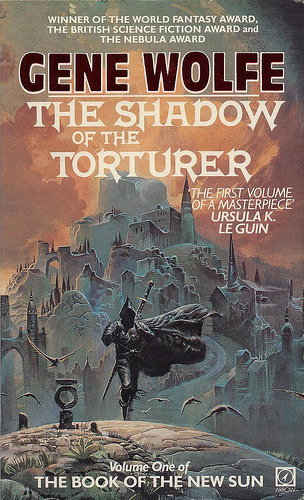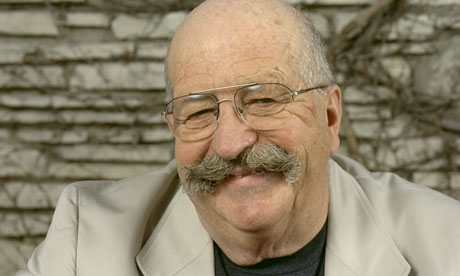SFX Book Club: The Shadow of the Torturer
And so, by the time you read this, another Worldcon will be more or less over; another army of fans, authors, artists, editors and agents dispersed to return to everyday life. It is, for me at least, both a relief (you can’t keep up a con-level of sleep deprivation, poor nutrition and alcohol abuse for much longer without suffering permanent consequences!) and a wrench (this is my tribe and I’ll miss them).
So in order to ameliorate that let-down a little, I thought it might be nice to reflect on a book that I first read as a direct result of finding the author interesting on panels at my first Worldcon, Aussiecon II, back in 1985. The author is the genius known as Gene Wolfe, and the book is the masterpiece The Shadow of the Torturer . . .
All novels are fantasies. Some are more honest about it . . .
Discuss.
Only, if you’re Gene Wolfe, you don’t have to discuss, you simply state. But life isn’t that simple. The quote above might be Gene Wolfe talking about Neil Gaiman, but often the words quoted as Wolfe’s are actually those of his characters.
‘We say “I will” and “I will not” and imagine ourselves . . . our own masters, when the truth is our masters are sleeping.’
Who knows if those are also Wolfe’s thoughts? Come to that, who knows if they’re the real thoughts of his main characters? Since these often lie to themselves, to other characters, and to the reader (whom they frequently address directly).
 When Gene Wolfe published The Shadow of the Torturer in 1980 he was senior editor on Plant Engineering magazine, had written a hundred or so SF short stories and won a Nebula in 1973 for ‘The Death of Doctor Island’. But nothing prepared readers for what was to come.
When Gene Wolfe published The Shadow of the Torturer in 1980 he was senior editor on Plant Engineering magazine, had written a hundred or so SF short stories and won a Nebula in 1973 for ‘The Death of Doctor Island’. But nothing prepared readers for what was to come.
The Shadow of the Torturer is – for me – the definitive science fantasy novel. No-one did it better before Wolfe, and no-one has done it better since . . . including Gene Wolfe himself. From their richly textured world where ancient spaceships nestle as turrets in castles so old no-one can remember why they were built, to their casual description of torture as everyday business, the novels making up The Book of the New Sun – of which Shadow is the first – are brilliant monsters. Anguished, imagery-laden, and brilliant. But monstrous.
This is Catholic guilt meshed with the dying days of our world. A retelling of the Christ myth, by someone who knows its absolute truth. Or maybe it’s a retelling of the Apollo myth, with its pun on son/sun . . .
There are some basic rules to writing.
- Make your main character likeable.
- Don’t muddle your readers.
- Avoid flashbacks.
- If you must have flashbacks, signpost them (for example: ‘London 1983 was a very different place’).
- Don’t foreshadow and give away what will happen later.
Tutors recite these as if reading them from tablets of stone. Critics praise or damn based on how many are obeyed or broken. Gene Wolfe ignores them.
His main character is an apprentice torturer; the story slides backwards and forwards in time, told by an insane future emperor (think I, Claudius) and we know what’s going to happen next, because most of the time we’re told in advance.
The Shadow of the Torturer kicks off with the drowning and resurrection of Severian, its main character, flashes back, and then loops forward to a grave robbery, with the lightly decaying body of a woman being stolen by an aristocrat. No attempt is made to explain who people are, why they’re doing what they’re doing or even the geographical location the action is taking place. The language is dense, almost biblical.
In the first nine pages we’re given an inkling, but no more, of the politics and class underlying a world that is both past and future, fantastical and bound by the laws of science. Yet we know the world runs on rules, without knowing what the rules are. Because the first rule of world building is to make it real, and Gene Wolfe’s world seems so real it extends beyond the edges of the page.
Volume one of The Book of the New Sun won the World Fantasy Award and the British Science Fiction Award. Volume two won a Nebula and was shortlisted for the Hugo, while volumes three and four were both nominated for a Nebula, with the third being nominated for another Hugo.
Most novels can be pinned down to their time. The War of the Worlds is obviously late Victorian; Neuromancer is an obvious response to the Reaganomics. The Shadow of the Torturer could have been written in 1960 or it could have been written last year. It is one man’s vision of redemption. As personal as a painting by Hieronymus Bosch.
(And yes, I know it owes a debt to Jack Vance’s The Dying Earth, which turns up in Severian’s world as The Book of Gold. It’s what Wolfe did with the inspiration that makes it so unusual.)
The Shadow of the Torturer is available as an SF Gateway eBook and, with The Claw of the Conciliator, as The Book of the New Sun: Volume 1. You can read more about Gene Wolfe in his entry at The Encyclopedia of Science Fiction.
This piece was written by Jon Courtenay Grimwood and appears courtesy of SFX magazine, where it was originally published as part of their regular SFX Book Club feature. You can subscribe to SFX magazine here and find more Book Club articles here.
Jon Courtenay Grimwood is the acclaimed author of the award-winning Ashraf Bey trilogy. His latest novel is The Exiled Blade: Act Three of the Assassini, which is available in paperback and as an eBook. His website is www.j-cg.co.uk and you can follow him on twitter @JonCG_novelist.



